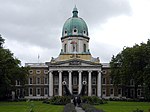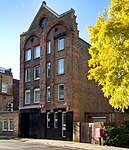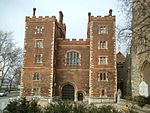Kennington Road

Kennington Road is a long straight road, approximately a mile in length, in the London Borough of Lambeth in London, England, running south from Westminster Bridge Road (at the junction with Baylis Road to the north-east) to Kennington Park Road. The road is designated as the A23. Formerly open land, in 1751, a year after Westminster Bridge was opened, it was constructed by the Turnpike Trustees to improve communication from the bridge to routes south of the river Thames. With the growing popularity of Brighton as a resort in the later eighteenth century it became part of the route there, used by George IV on his excursions there and later for other London to Brighton events such as the London to Brighton Veteran Car Run. Lambeth North Underground station is located at the north end of the road at the junction with Westminster Bridge Road. The Imperial War Museum (formerly the Bethlem Royal Hospital) is to the east, in Geraldine Mary Harmsworth Park, south of the junction with Lambeth Road (A3203). Kennington Park is to the south. The Lincoln Tower built by Christopher Newman Hall in the late nineteenth century in memory of Abraham Lincoln and the Emancipation Proclamation is situated close to the junction with Westminster Bridge Road along with the modernist Christ Church and Upton Chapel that replaces Newman Hall's Victorian gothic chapel that was destroyed during the Second World War. Though there has been much rebuilding and demolition, many of the grand Georgian terraces lining Kennington Road still survive. The Old Town Hall for the Metropolitan Borough of Lambeth also still survives.
Excerpt from the Wikipedia article Kennington Road (License: CC BY-SA 3.0, Authors, Images).Kennington Road
Kennington Road, London Kennington (London Borough of Lambeth)
Geographical coordinates (GPS) Address Nearby Places Show on map
Geographical coordinates (GPS)
| Latitude | Longitude |
|---|---|
| N 51.494 ° | E -0.11088 ° |
Address
Kennington Road 126
SE11 6RD London, Kennington (London Borough of Lambeth)
England, United Kingdom
Open on Google Maps








